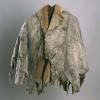Quilt No.636IJ - Ian Johnson

Russell McNickle shot the kangaroos at Hillston NSW. Mr. Hartley Schultz tanned them at the Wagga Wagga tannery and made the rug in 1958. It was owned by Bryce McNickle (brother of Betty Johnson) and, on his death, passed to Ian Johnson. It is not used now.
Russell McNickle shot the kangaroos on Milthorpe's property 'Walanthray' Hillston NSW with a 22 calibre BRNO rifle in 1958. The skins are from the big red, the grey, the black scrubber and/or the blue flyer. No licence was necessary to shoot the roos. Russell salted the skins down and they were then taken to the Schultz tannery in Wagga Wagga where Hartley Schultz was responsible for tanning, design and making the rugs.
Russell bought the rifle (and bullets) for 60 pounds and paid for it within a year by trapping and shooting rabbits and shooting roos.
Jarvie and Kelvin (McNickle) also shot and skinned the kangaroos.






